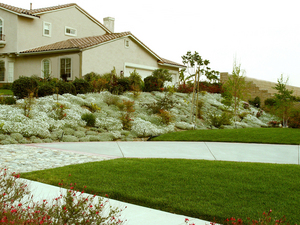When my husband and I moved into our new home we just loved the English ivy growing in a 16 foot flower bed in front of our porch. It had beautiful, trailing vines silently creeping over the six inch front wall of our concrete porch and was starting to grow on the top. It did this on the other side, trying to cover half our walkway to the front door. We just thought it so quaint and Victorian looking. After a few weeks, we soon changed our minds.
Although we loved the look of the English ivy, we soon discovered that the maintenance needed to keep this highly invasive plant from taking over our walkway and porch was just a little too much work for us. It was also growing part way up one wall of our house.
English ivy makes an excellent ground cover for shaded area provided the soil is well-drained and enriched with organic compost and peat moss. If ivy is planted in full sun it will not winter over as well because winter burn (a form of dehydration), may occur. It is an excellent plant for hills or slopes as it helps discourage soil erosion. It does this by sinking its root system deeply and densely into the soil and knitting them through the dirt in such a way that it helps prevent soil erosion.
Because English ivy has aerial roots, which enable it to climb and cling to vertical surfaces, people will plant it near walls and fences to add lush, green foliage to a somewhat bare area.
English ivy is best suited for cooler zones four though seven. Ivy is propagated from cuttings and should be planted in the spring about 12 inches apart. Do not fertilize for the first two to three months, after this time they should be fed every other month during the growing season with an all-purpose fertilizer having a ratio of 10-10-10.
Regular pruning should be done two to three times a year, but with our English ivy, we were doing it every two weeks to prevent it from overtaking our porch, walkway and side of the house.
Some diseases ivy is susceptible to are bacterial leaf spot and stem canker. The pests that can help destroy English ivy are spider mites, mealy bugs, white flies, aphids, and scale.
Some varieties of Ivy can be grown as a house plant, requiring four or more house of direct sunlight daily. It likes cool temperatures, moist soil and a good helping of fertilizer once a month.
Our beautiful English ivy become too much for us to maintain, so we removed it (not an easy task getting all the roots out), and put down some lovely miniature boxwood bushes and mulched the remaining area. I did miss some of the ivy roots because each spring a lone vine will suddenly appear creeping up the wall of my house.
Source: www.mrec.ifas.ufl.edu






